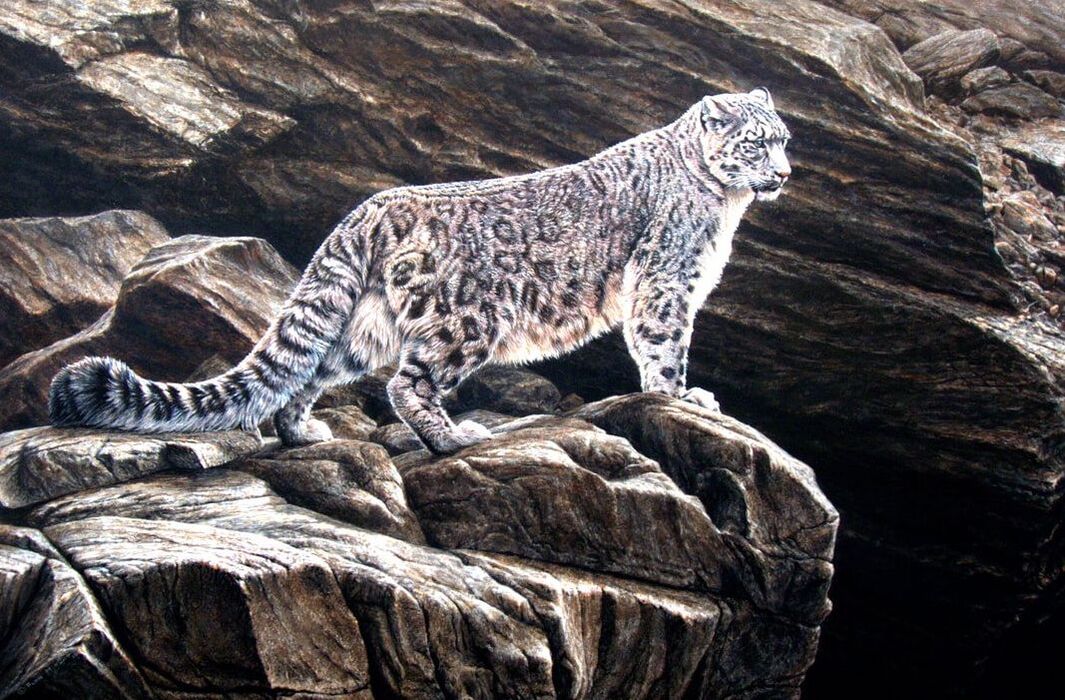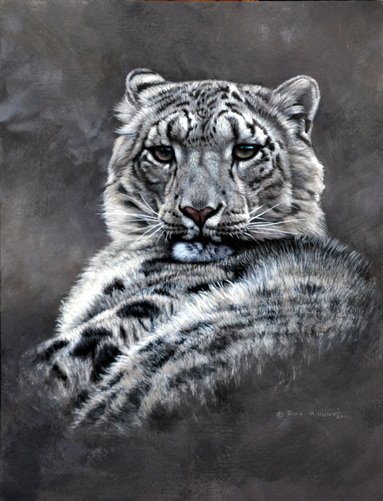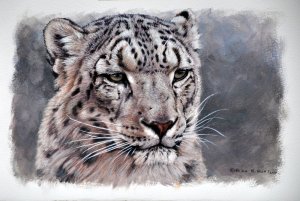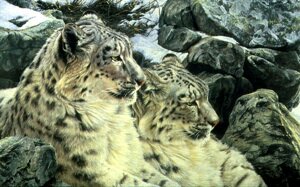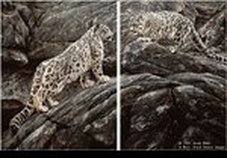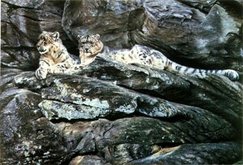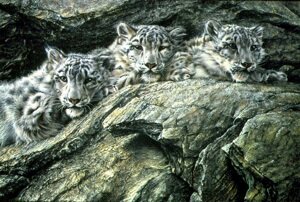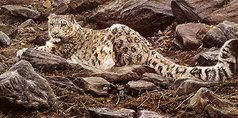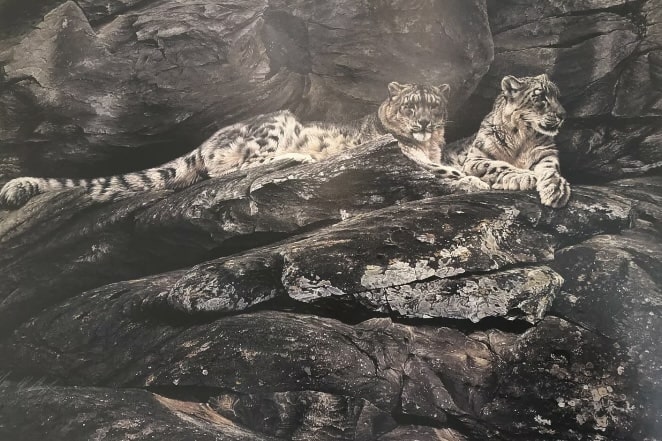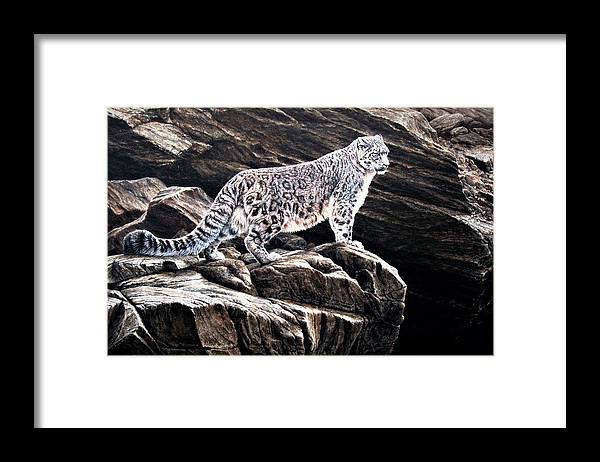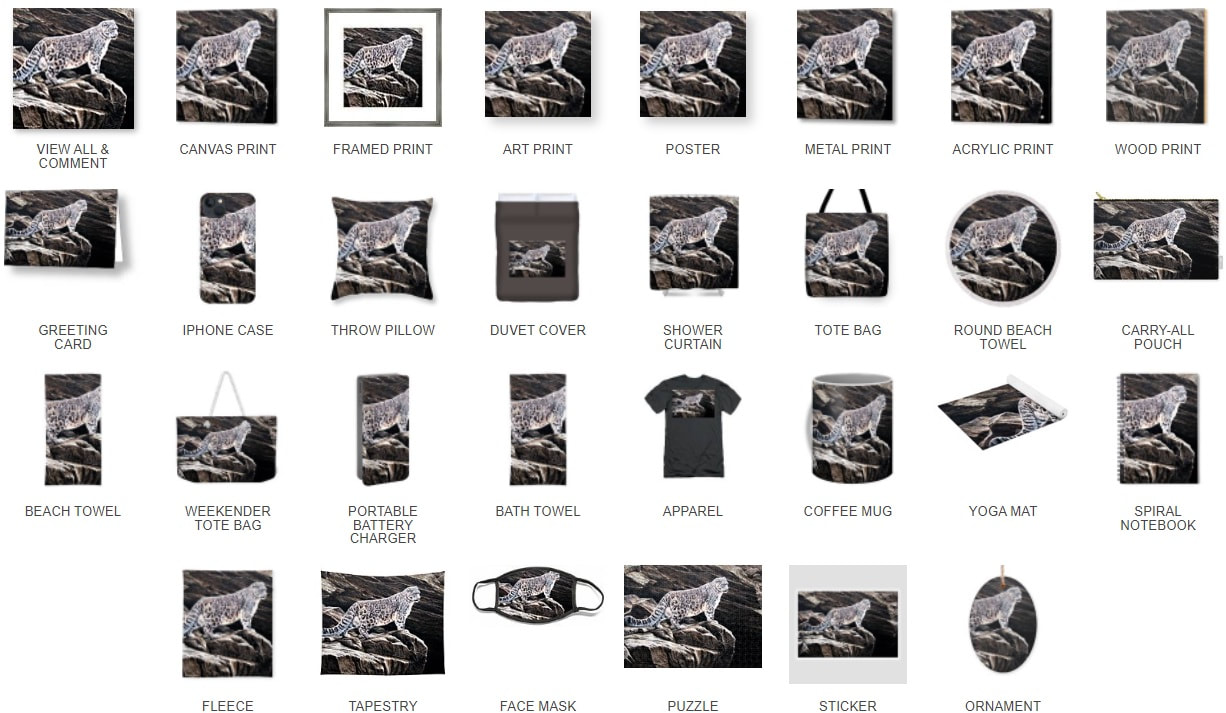ORIGINAL PAINTINGS OF SNOW LEOPARDS
The snow leopard is one of the few big cat's that Alan has not seen in the wild however it still remains Alan's favourite big cat. The snow leopard has gorgeous fur which provides it with camouflage in its habitat in the mountains.
"With a population of only hundreds left in the wild, I am appalled that these wonderful creatures are still being killed for their fur"
"With a population of only hundreds left in the wild, I am appalled that these wonderful creatures are still being killed for their fur"
Original Snow Leopard Paintings For Sale by Alan M Hunt
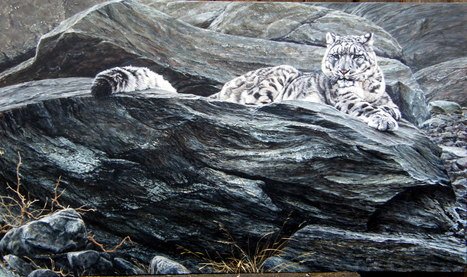 Snow Leopard on Rock SOLD
Snow Leopard on Rock SOLD
The snow leopard (Uncia uncia or Panthera uncia) is a medium to large cat native to the mountain ranges of Central Asia. Snow leopards live between 3,000 and 5,500 metres (9,800 and 18,000 ft) above sea level in the rocky mountain ranges of Central Asia.
Because of their secretive nature means that their exact numbers are not known, although it has been estimated that between 3,500 and 7,000 snow leopards exist in the wild and between 600 and 700 in zoos worldwide.
Original Snow Leopard Painting By Alan M Hunt
Snow leopards are smaller than the other big cats but like them they exhibit a range of sizes, generally weighing between 27 and 54 kilograms (60 and 120 lb). Body length ranges from 75 to 130 centimetres (30 to 50 in), with a tail of nearly the same length.
Snow leopards have long thick fur, the base colour of which varies from smoky grey to yellowish tan, with whitish underparts. They have dark grey to black open rosettes on their body with small spots of the same colour on their heads and larger spots on their legs and tail.
Because of their secretive nature means that their exact numbers are not known, although it has been estimated that between 3,500 and 7,000 snow leopards exist in the wild and between 600 and 700 in zoos worldwide.
Original Snow Leopard Painting By Alan M Hunt
Snow leopards are smaller than the other big cats but like them they exhibit a range of sizes, generally weighing between 27 and 54 kilograms (60 and 120 lb). Body length ranges from 75 to 130 centimetres (30 to 50 in), with a tail of nearly the same length.
Snow leopards have long thick fur, the base colour of which varies from smoky grey to yellowish tan, with whitish underparts. They have dark grey to black open rosettes on their body with small spots of the same colour on their heads and larger spots on their legs and tail.
SNOW LEOPARD Conservation efforts
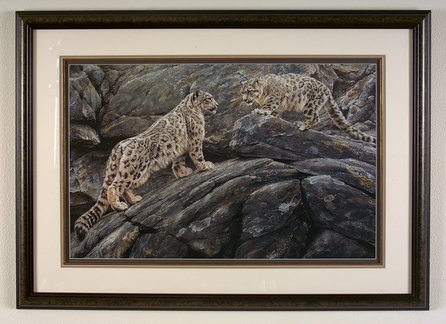
Himalayan Love Song Not Available by Alan M Hunt
There are numerous agencies working to conserve the snow leopard and its threatened mountain ecosystems. These include the Snow Leopard Trust, the Snow Leopard Conservancy and the Snow Leopard Network. These groups and numerous national governments from the snow leopard's range, non-profits and donors from around the world recently worked together at the 10th International Snow Leopard Conference in Beijing. Their focus on research, community programs in snow leopard regions and education programs are aimed at understanding the cat's needs as well as the needs of the villagers and herder communities impacting snow leopards' lives and habitat
Snow leopards have symbolic meaning for Turkic people of Central Asia, where the animal is known as irbis or bars, so it is widely used in heraldry and as an emblem.
The snow leopard (in heraldry known as the ounce) (Aq Bars) is a national symbol for Tatars and Kazakhs: a snow leopard is found on the official seal of the city of Almaty, and a winged snow leopard is found on Tatarstan's coat of arms. A similar leopard is featured on the coat of arms of North Ossetia-Alania. The Snow Leopard award was given to Soviet mountaineers who scaled all five of the Soviet Union's 7000m peaks. In addition, the snow leopard is the symbol of the Girl Scout Association of Kyrgyzstan.
Snow leopards have symbolic meaning for Turkic people of Central Asia, where the animal is known as irbis or bars, so it is widely used in heraldry and as an emblem.
The snow leopard (in heraldry known as the ounce) (Aq Bars) is a national symbol for Tatars and Kazakhs: a snow leopard is found on the official seal of the city of Almaty, and a winged snow leopard is found on Tatarstan's coat of arms. A similar leopard is featured on the coat of arms of North Ossetia-Alania. The Snow Leopard award was given to Soviet mountaineers who scaled all five of the Soviet Union's 7000m peaks. In addition, the snow leopard is the symbol of the Girl Scout Association of Kyrgyzstan.
Snow Leopards
|
The Snow Leopard with its Oriental features, soft dense coat and long elegant tail is one of the most beautiful and least studied of all our big cats. Roaring on the high mountains of Asia and the Himalayas it is, like most of the other large cats a solitary creature. Only when females are accompanied by their young or during mating is this not true and even then the mating pair will only cohabit for six or seven days at a time.
The inspiration for this Snow Leopard painting is from sketches of the female Snow Leopard at the San Diego Zoo and the male Snow Leopard from the Cincinnati Zoo, although as far as I am aware, their official mating has only occurred in this painting, |
Snow Leopard Prints
Many of these Snow Leopard Prints can be found on Ebay or Fine Art America
Snow Leopard prints, products and gifts not available on the high street
Snow Leopard Art Gifts and Presents
A Range of Snow Leopard Wall Art Products including
Snow leopard Canvas Prints, Framed Prints, Acrylic Prints, Metal Prints, Wood Prints and Posters.
Snow Leopard Home Decor Products including
Snow leopard Throw Pillows, Fleece Blankets, Duvet Covers, Shower Curtains,Tote Bags and Hand Towels.
Snow Leopard Lifestyle Products
Snow leopard Tote Bags, Weekender Tote Bags, Carry-All Pouches, Phone Cases, Portable Battery Charger and Yoga Mats.
SNow Leopard Stationery Items
Snow leopard Greeting Cards, Stickers and Spiral Notebooks.
Snow Leopard Beach Items
Snow leopard Beach Towel, Beach Sheet, Round Beach Towels, Weekender Tote Bags and Bath Towels.
Snow leopard Canvas Prints, Framed Prints, Acrylic Prints, Metal Prints, Wood Prints and Posters.
Snow Leopard Home Decor Products including
Snow leopard Throw Pillows, Fleece Blankets, Duvet Covers, Shower Curtains,Tote Bags and Hand Towels.
Snow Leopard Lifestyle Products
Snow leopard Tote Bags, Weekender Tote Bags, Carry-All Pouches, Phone Cases, Portable Battery Charger and Yoga Mats.
SNow Leopard Stationery Items
Snow leopard Greeting Cards, Stickers and Spiral Notebooks.
Snow Leopard Beach Items
Snow leopard Beach Towel, Beach Sheet, Round Beach Towels, Weekender Tote Bags and Bath Towels.
View more of Alan's big cat paintings
Cheetahs
Jaguars
Leopards
Lions
Tigers
Snow Leopards
Snow Leopards will always be my favourite
Cheetahs
Jaguars
Leopards
Lions
Tigers
Snow Leopards
Snow Leopards will always be my favourite

